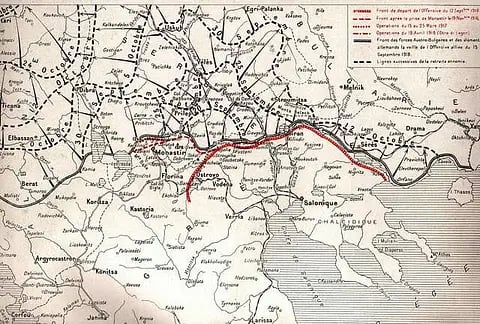"How Did WW1 Start? 5 Key Causes and Hidden Triggers"
Uncover the hidden causes of World War I! From militarism and alliances to the assassination of Archduke Franz Ferdinand, explore the 5 critical factors that ignited the Great War in this ultimate guide.


Introduction: The World Before the War
The early 20th century was a time of unprecedented technological progress and political tension. Europe’s empires, fueled by industrial might and colonial ambition, stood on a knife’s edge. World War I (1914–1918), often termed the "Great War," didn’t erupt overnight. It was the culmination of decades of rivalry, mistrust, and a single spark that set the world ablaze. In this detailed exploration, we unravel the complex web of events that led to one of history’s deadliest conflicts.
The Long-Term Causes: Understanding the MAIN Factors
Historians use the acronym MAIN (Militarism, Alliances, Imperialism, Nationalism) to explain the underlying causes of WW1. Let’s dissect each:
1. Militarism: The Arms Race and War Plans
Naval Supremacy Battles: Britain’s Royal Navy dominated the seas, but Germany’s Kaiserliche Marine sought to challenge this with its Dreadnought battleships. By 1914, Germany had 17 dreadnoughts to Britain’s 29, sparking a costly naval arms race.
Army Expansion: Nations adopted conscription, with Germany training 340,000 soldiers annually and France mobilizing 80% of its male population.
Rigid War Strategies: Germany’s Schlieffen Plan aimed to swiftly defeat France before facing Russia. France’s Plan XVII focused on reclaiming Alsace-Lorraine. These inflexible strategies left little room for diplomacy.
2. Alliances: A Continent Divided
Triple Entente (1907): France, Russia, and Britain formed a counterweight to German power.
Triple Alliance (1882): Germany, Austria-Hungary, and Italy (Italy later defected in 1915).
Secret Treaties: Russia pledged to defend Serbia; Germany promised Austria-Hungary unconditional support (the "Blank Check").
Ottoman Empire’s Role: Joined the Central Powers in 1914 to counter Russia’s influence in the Balkans.
Key Insight: Alliances transformed regional disputes into global wars. A single declaration of war activated a chain reaction.
3. Imperialism: Scramble for Colonies
Africa and Asia: European powers competed for resources and prestige. The 1884 Berlin Conference divided Africa, but tensions lingered.
Moroccan Crises (1905, 1911): Germany challenged France’s dominance in Morocco, nearly triggering war. Britain backed France, deepening Entente solidarity.
Austria-Hungary’s Balkan Ambitions: The empire sought to curb Serbian nationalism, fearing it would inspire Slavic revolts.
4. Nationalism: Pride and Ethnic Strife
Pan-Slavism: Serbia aimed to unite South Slavs under one state, directly threatening Austria-Hungary’s multi-ethnic empire.
French Revanchism: Resentment over losing Alsace-Lorraine to Germany in 1871 fueled French nationalism.
Austria-Hungary’s Fragility: Ethnic groups like Hungarians, Czechs, and Serbs demanded autonomy, weakening the empire.
The Spark: Assassination of Archduke Franz Ferdinand
On June 28, 1914, Gavrilo Princip, a 19-year-old Bosnian Serb nationalist, shot Archduke Franz Ferdinand and his wife Sophie in Sarajevo. This event wasn’t random—it was the climax of Balkan tensions:
Black Hand Society: A secret Serbian group aiming to liberate Bosnia from Austro-Hungarian rule trained and armed Princip.
Austria-Hungary’s Ultimatum: With Germany’s backing, they demanded Serbia allow Austrian officials to investigate the assassination on Serbian soil—a violation of sovereignty.
Serbia’s Partial Acceptance: Serbia agreed to most terms but refused the investigative clause. Austria-Hungary declared war on July 28, 1914.
The July Crisis: How Diplomacy Failed
The month following the assassination saw frantic negotiations, but rigid alliances and militarism doomed peace efforts:
July 23: Austria-Hungary delivers its ultimatum to Serbia.
July 25: Serbia mobilizes its army; Russia begins "partial mobilization" to support Serbia.
July 28: Austria-Hungary declares war on Serbia.
July 30: Russia orders full mobilization, prompting Germany to demand a halt.
August 1: Germany declares war on Russia and invades Luxembourg.
August 3: Germany declares war on France, invoking the Schlieffen Plan.
August 4: Germany invades neutral Belgium, prompting Britain to join the war.
Why It Escalated:
Germany feared a two-front war and prioritized speed over diplomacy.
Russia’s mobilization, seen as an act of war, forced Germany’s hand.
Britain’s entry guaranteed a global conflict, as its empire spanned five continents.
Debunking Myths: Misconceptions About WW1’s Origins
"The War Was Inevitable":
While tensions were high, leaders had opportunities to de-escalate. For instance, Germany could have moderated Austria-Hungary’s demands."Germany Was Solely Responsible":
The 1919 Treaty of Versailles blamed Germany, but historians argue shared culpability among empires for militarism and inflexible policies."It Was Only About the Assassination":
The assassination was the trigger, not the cause. Without the MAIN factors, the crisis might have remained localized.
The Immediate Aftermath: From Local War to Global Catastrophe
By August 1914, the war spread beyond Europe:
Colonial Theaters: Fighting erupted in Africa, the Middle East, and Asia.
Global Alliances: Japan joined the Entente to seize German Pacific colonies; the Ottoman Empire blocked Russian supply routes via the Dardanelles.
Trench Warfare Begins: By September 1914, the Western Front stalemated into 400 miles of trenches from Belgium to Switzerland.
Legacy of WW1: Reshaping the Modern World
Collapse of Empires: The Austro-Hungarian, Ottoman, German, and Russian empires dissolved.
New Nations: Poland, Czechoslovakia, and Yugoslavia emerged from the rubble.
Seeds of WWII: The Treaty of Versailles’ harsh terms (e.g., German reparations) fueled resentment, paving the way for Hitler’s rise.
FAQs: Answering Key Questions
1. Why did the U.S. join WW1?
The U.S. entered in 1917 due to unrestricted submarine warfare (e.g., sinking of the Lusitania) and the Zimmerman Telegram, where Germany sought Mexico as an ally.
2. What role did technology play?
Machine guns, poison gas, and tanks made WW1 exceptionally deadly, resulting in 20 million deaths.
3. Could Austria-Hungary have avoided war?
Yes—if it had accepted Serbia’s concessions or pursued diplomatic mediation.
Conclusion: Lessons from the Great War
World War I was not an accident but the result of systemic failures—entrenched militarism, rigid alliances, and unchecked nationalism. Its legacy reminds us that peace requires cooperation, adaptability, and empathy in the face of division. As we reflect on the past, let us strive to learn from its tragedies.
Call to Action: Share this article to keep history alive! For more insights, explore our series on WW1 battles and unsung heroes.
